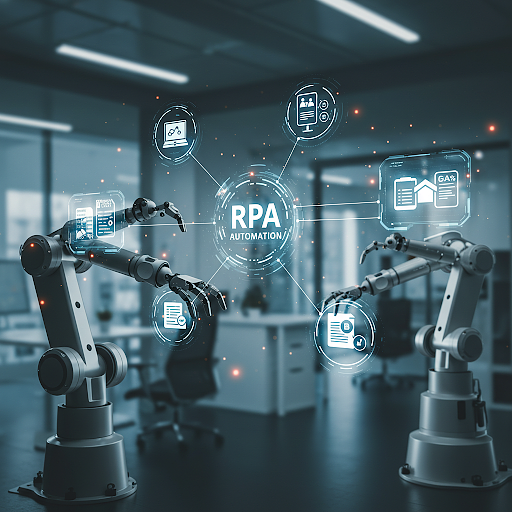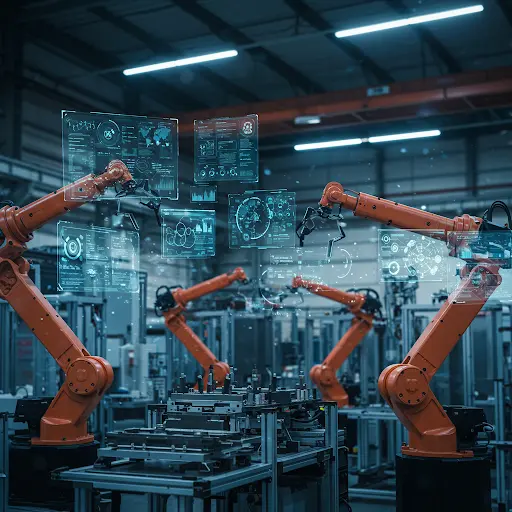In today's fast-paced business world, efficiency is key to staying competitive. Companies that cling to outdated, manual processes risk falling behind. This post will delve into two powerful automation approaches – RPA and Agentic Automation – to help you unlock new levels of efficiency and gain a competitive edge.
What is RPA?
Robotic Process Automation, or RPA, specializes in the automation of manual operations that are rule-based and recurring by nature. The implementation of RPA leads to an exponential growth of efficiency and accuracy of such tasks through the utilization of software bots, which perfectly emulate human activities such as logging in and out of applications, entering data, and completing pre-set tasks.
What is Agentic automation?
Unlike RPA, Agentic Automation is not restricted to rule-based tasks and can extrapolate decisions based on incoming data. The term ‘Agentic’ signifies the system's capability to operate in a more independent and proactive manner, allowing for autonomous decision-making.
Key Differences:
Task Complexity:
- RPA:
Ideal for structured, repetitive, rule-based tasks with minimal exceptions. - Agentic Automation:
Designed for unstructured, dynamic tasks that require decision-making, learning, and adaptation. They can handle exceptions and unexpected situations.
Decision-Making:
- RPA:
Relies on pre-defined rules. Cannot make decisions outside of those rules. - Agentic Automation:
Employs AI and machine learning to make decisions based on context and experience.
Adaptability:
- RPA:
Requires reprogramming or updates when processes change. - Agentic Automation:
Can learn and adapt to changes in the environment and processes, reducing the need for constant manual intervention.
Intelligence:
- RPA:
Limited to following instructions. Does not possess true intelligence. - Agentic Automation:
Leverages AI and ML to exhibit intelligent behavior, such as problem-solving and learning.
Human Intervention:
- RPA:
Often requires human intervention for exceptions or complex scenarios. - Agentic Automation:
Designed to operate more autonomously, reducing the need for human intervention.
Implementation:
- RPA:
Typically faster and easier to implement for well-defined processes. - Agentic Automation:
Can be more complex to implement due to the AI/ML component.
Strengths and Weaknesses of RPA:
Strengths:
- The use of RPA can bring about a drastic reduction in the time consumed to complete tasks, thereby increasing overall productivity.
- RPA has proved to be economically favorable as it can function ceaselessly, hence making it a cost-effective alternative to human labor.
- RPA bots are less prone to committing errors, thus decreasing the probability of complications.
- Due to its characteristic simplicity, RPA makes it easy to augment or diminish operations according to requirements.
Weaknesses:
- RPA cannot learn from the tasks it carries out, as the bot's intelligence is only as far reaching as its pre-programmed responses.
- Processing unstructured data is a challenge for RPA, as it requires guidelines or rules to function effectively.
Strengths and Weaknesses of Agentic Automation:
Strengths:
- Agentic systems are capable of learning and evolving from every task they carry out. These insights help to enhance performance over time.
- Unlike RPA, Agentic Automation can process and learn from unstructured data.
- Agentic systems can decision-make autonomously, thus reducing the need for continuous supervision.
Weaknesses:
- The initiation costs of Agentic Automation can be steep owing to the expense of the advanced technology deployed.
- The autonomous nature of Agentic systems may arouse concerns regarding trust and control.
When to use RPA or Agentic Automation?
RPA:

- Data entry and processing
- Form filling and submission
- Report generation
- Invoice processing
- Basic customer service tasks (e.g., answering FAQs)
Agentic Automation:

- Fraud detection
- Personalized recommendations
- Dynamic pricing
- Supply chain optimization
- Complex customer service interactions
- Anomaly detection
Future Trends:
- Convergence:
There is the potential for RPA and Agentic Automation to converge. Hybrid solutions can combine the strengths of both. RPA can be used for the initial data extraction from a system, and then passing that data to an AI agent for analysis, decision-making, and further processing. - AI advancements:
Improved natural language processing (NLP) allows agents to understand and interact with human language more effectively. Enhanced machine learning algorithms enable agents to learn from data and experience, improving their decision-making and problem-solving abilities. These advancements will lead to more sophisticated agents capable of handling increasingly complex tasks. - Democratization of AI:
Cloud-based AI services and pre-trained models are making it simpler and more affordable for businesses of all sizes to implement Agentic Automation. This means smaller companies can leverage the power of AI-driven automation without requiring a team of AI specialists.
Conclusion:
In conclusion, while both RPA and Agentic Automation come with their individual strengths, the choice between the two rests upon the specific requirements of an organization. For businesses seeking to automate repetitive, rule-based tasks, RPA serves as an ideal option, while Agentic Automation paves the way forward for tasks that demand decision-making abilities and learning from past experiences.
Being aware of their distinct differences will enable businesses to adopt the automation strategies that will most benefit their unique operations, creating a path towards a more efficient and effective digital future.
